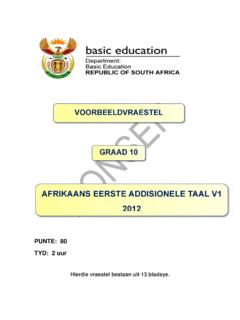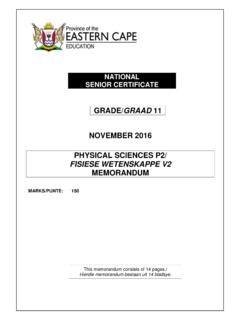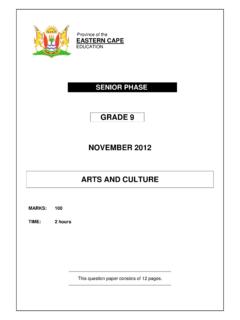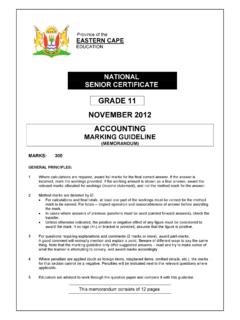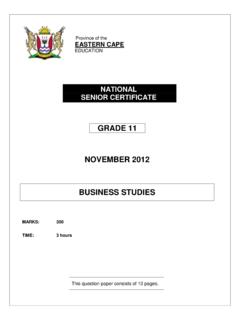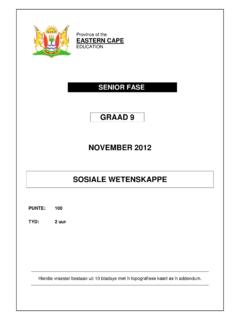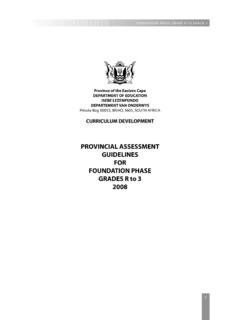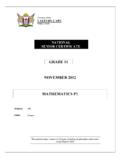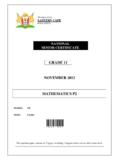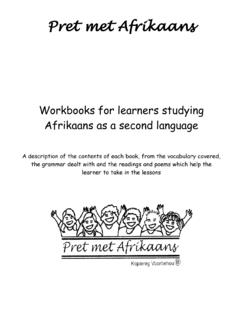Transcription of ANNUAL NATIONAL ASSESSMENT GRADE 4 …
1 ANNUAL NATIONAL ASSESSMENT . GRADE 4. english FIRST ADDITIONAL LANGUAGE. SET 1: 2012 EXEMPLAR. GUIDELINES FOR THE USE OF ANA EXEMPLARS. 1. General overview The ANNUAL NATIONAL ASSESSMENT (ANA) is a summative ASSESSMENT of the knowledge and skills that learners are expected to have developed by the end of each of the Grades 1 to 6 and 9. To support their school-based assessments and also ensure that learners gain the necessary confidence to participate with success in external assessments, panels of educators and subject specialists developed exemplar test questions that teachers can use in their Language and Mathematics lessons. The exemplar test questions were developed based on the curriculum that covers terms 1, 2 and 3 of the school year and a complete ANA model test for each GRADE has been provided.
2 The exemplars, which include the ANA model test, supplement the school-based ASSESSMENT that learners must undergo on a continuous basis and does not replace the school based ASSESSMENT . 2. The structure of the exemplar questions The exemplars are designed to illustrate different techniques or styles of assessing the same skills and/or knowledge. For instance, specific content knowledge or a skill can be assessed through a multiple-choice question (where learners select the best answer from the given options) or a statement (that requires learners to write a short answer or a paragraph) or other types of questions (asking learners to join given words/statements with lines, to complete given sentences or patterns, to show their answers with drawings or sketches, etc.)
3 Therefore, teachers will find a number of exemplar questions that are structured differently but are targeting the same specific content and skill. Exposure to a wide variety of questioning techniques or styles gives learners the necessary confidence to respond to different test items. 3. Links with other learning and teaching resource materials For the necessary integration, some of the exemplar texts and questions have been deliberately linked to the GRADE -relevant workbooks. The exemplars have also been aligned with the requirements of the NATIONAL Curriculum Statement (NCS), Grades R to 12, the Curriculum and ASSESSMENT Policy Statements (CAPS). for the relevant grades and the NATIONAL Protocol for ASSESSMENT .
4 These documents, together with any other that a school may provide, will constitute a rich resource base to help teachers in planning lessons and conducting formal ASSESSMENT . 4. How to use the exemplars While the exemplars for a GRADE and a subject have been compiled into one comprehensive set, the learner does not have to respond to the whole set in one sitting. The teacher should select exemplar questions that are relevant to the planned lesson at any given time. Carefully selected individual exemplar test questions, or a manageable group of questions, can be used at different stages of the teaching and learning process as follows: At the beginning of a lesson as a diagnostic test to identify learner strengths and weaknesses.
5 The diagnosis must lead to prompt feedback to learners and the development of appropriate lessons that address the identified weaknesses and consolidate the strengths. The diagnostic test could be given as homework to save instructional time in class. During the lesson as short formative tests to assess whether learners are developing the intended knowledge and skills as the lesson progresses and ensure that no learner is left behind. At the completion of a lesson or series of lessons as a summative test to assess if the learners have gained adequate understanding and can apply the knowledge and skills acquired in the completed lesson(s). Feedback to learners must be given promptly while the teacher decides on whether there are areas of the lesson(s) that need to be revisited to consolidate particular knowledge and skills.
6 1. At all stages to expose learners to different techniques of assessing or questioning, how to answer multiple-choice (MC) questions, open-ended (OE) or free-response (FR) questions, short- answer questions, etc. While diagnostic and formative tests may be shorter in terms of the number of questions included, the summative test will include relatively more questions, depending on the work that has been covered at a particular point in time. It is important to ensure that learners eventually get sufficient practice in responding to full tests of the type of the ANA model test. 5. Memoranda or marking guidelines A typical example of the expected responses (marking guidelines) has been given for each exemplar test question and for the ANA model test.
7 Teachers must bear in mind that the marking guidelines can in no way be exhaustive. They can only provide broad principles of expected responses and teachers must interrogate and reward acceptable options and variations of the acceptable response(s) given by learners. 6. Curriculum coverage It is extremely critical that the curriculum must be covered in full in every class. The exemplars for each GRADE and subject do not represent the entire curriculum. They merely sample important knowledge and skills and covers work relating to terms 1, 2 and 3 of the school year. The pacing of work to be covered according to the school terms is specified in the relevant CAPS documents. 7. Conclusion The goal of the Department is to improve the levels and quality of learner performance in the critical foundational skills of literacy and numeracy.
8 ANA is one instrument the Department uses to monitor whether learner performance is improving. Districts and schools are expected to support teachers and provide necessary resources to improve the effectiveness of teaching and learning in the schools. By using the ANA. exemplars as part of their teaching resources, teachers will help learners become familiar with different styles and techniques of assessing. With proper use, the exemplars should help learners acquire appropriate knowledge and develop relevant skills to learn effectively and perform better in subsequent ANA tests. 2. Read the passage below and answer the questions. Khotso loves the sunlight. It makes him happy because he can practise soccer.
9 He often gets up early when the sun rises, so that he can practise soccer before going to school. So, about three or four mornings a week, Khotso is up with the sun and birds, kicking and dribbling the ball. Khotso would love to play soccer for South Africa when he grows up. It is his ambition to be a striker for Bafana Bafana. Khotso also usually practises after school. So, about two or three times a week, he practises from three to five o'clock in the afternoon. He always practises on Sunday afternoons. So, every Sunday afternoon, he is out in the garden kicking his soccer ball. If Khotso had his way he would never stop practising because he never gets tired of soccer. Sometimes he even dreams about soccer.
10 1. Circle the letter of the correct answer. Which is the best title for this story? Khotso .. A and the sunlight. B loves soccer. C plays for Bafana Bafana. D is a good striker. (1). Fill in the missing word Khotso loves _____. (1). 3. State whether the following sentence is TRUE or FALSE. Give a reason for your answer. Khotso wakes up late every morning. Tick the correct answer. TRUE FALSE. _____ (2). Do you think Khotso loves soccer? YES NO. Give a reason for your answer. _____ (2). Fill in the blank space. _____ loves soccer. (1). 2. Circle the letter of the correct answer that best describes the character of Khotso. A Active B Lazy C Careless D Naughty (1). Complete the sentence.
